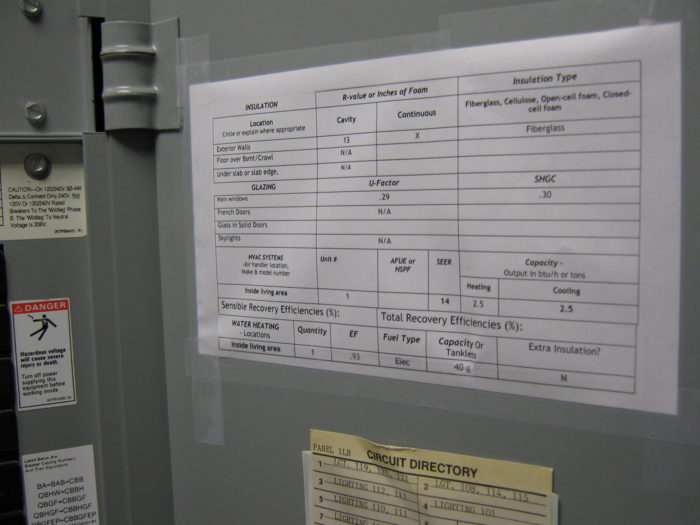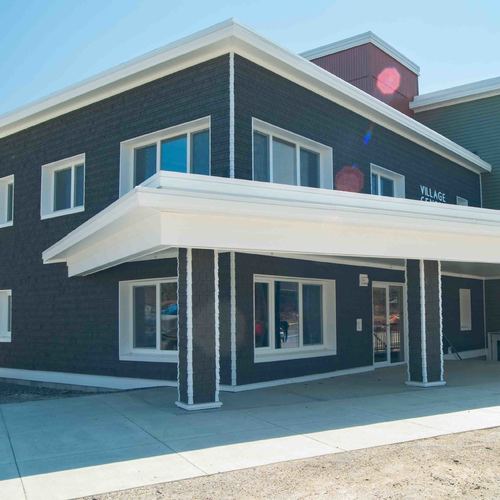
Image Credit: Underwood
A newly adopted provision in the 2006 edition of the International Residential Code (IRC) requires that a permanent certificate be posted on the electrical distribution panel. This certificate is for the express purpose of identifying the efficiency of various energy components of the home and must include the following:
- The predominate R-value of insulation in ceiling/roof, walls, foundation, crawl space wall, and floor;
- U-factors for windows, skylights, etc. (where there is more than one value, the value covering the largest area must be listed);
- The solar heat gain coefficient (SHGC) of windows, skylights, etc. (again, where there is more than one value, the value covering the largest area must be listed);
- The types and efficiencies of heating, cooling, and water heating equipment.
The premise is that posting these details will increase demand for more energy-efficient homes.
There are some drawbacks, however. First, some types of insulation, such as blown insulation, which tends to settle, lose thermal values over time. Energy-efficient measures for windows or doors and associated weather-stripping, if not maintained, will also lose efficiency. Heating and cooling equipment will lose efficiency with considerable use. So, the unsuspecting buyer may have a false sense of security in the label. Because of this, the 2012 edition of the IRC may include a provision about the potential for declining energy efficient values for a variety of products.
In any case, asking the builder or registered design professional to post such a notice is a great advancement. Now, the responsibility for installing energy efficient measures is assigned.
Weekly Newsletter
Get building science and energy efficiency advice, plus special offers, in your inbox.













2 Comments
Posting energy efficiency information
It's a great idea to require important energy performance information to be posted in an accessible spot in the house. It wouldn't take much work to develop a standardized form. This would be especially helpful when energy retrofits are performed on an older house, so that new owners wouldn't be left in the dark about what had been done before they got there. Eventually, perhaps this information could work its way up to the disclosure form that is required in real estate transactions.
HHI should be added to home energy efficiency postings
Posting R-values, U-factors, SHGCs and mechanical room equipment descriptions is a great idea, but it doesn't go far enough. Calculated values of
HHI-SHELL
and
HHI-MECH
need to be posted as well. These values let the home buyer know very simply and quickly how a house stacks up against others with respect to its thermal performance, which after all, is the biggest energy CONSUMPTION component of a house.
The HHI-SHELL is the number of BTUs per square foot per heating degree day (BTU/sf/HDD) the structure shell required to maintain comfortable temperatures in winter in the local climate. So, naturally, passive solar gain will reduce HHI-SHELL.
The HHI-MECH is the BTU/sf/HDD of imported energy that the mechanical system must have dumped into it to provide the shell with what it needs. HHI-MECH is higher because some heat goes up the chimney.
These two numbers as well as the other values should be posted prominently in two places, in the mechanical room and at the main electrical panel.
When shopping for a house, the house with the lower HHI-MECH IS the more energy efficient house. HHI is the equivalent of the EPA MPG for vehicles.
Of course, how the occupants “drive” the house can make an enormous difference. So, occupants should calculate their HHI-OCC because we all know “your mileage may vary.” .
HHI-OCC is the BTU/sf/HDD for heating determined from gas and electric bills after subtracting out water heating, cooking, lighting, grilling, etc. HHI-OCC may be higher or lower than HHI-MECH. “Lower” would typically indicate very energy conscious occupants, while “higher” would usually indicate occupant behaviors and choices that are not very energy efficient. By comparing HHI-OCC with HHI-MECH, occupants can gauge how energy efficient THEY are.
You would think that a Home Cooling Index (HCI) for the summer cooling season would be required also, but it is not. The HHI and the HCI correlate so well in most areas, that only the HHI is required to compare the energy efficiencies of houses.
The HERS index is not a good measure of energy efficiency. It mixes home energy efficiency with occupant choices/behavior and with energy generation. Under HERS a house with very poor energy efficiency (e.g., heat flow through the shell is high) can have a HERS of zero (0) with the additions of enough solar photovoltaic panels. So, HERS can’t be used as an energy efficiency measure.
For more information on HHI see
http://www.homeenergy.org/article_full.php?id=612&article_title=MPG_for_Homes
Log in or create an account to post a comment.
Sign up Log in